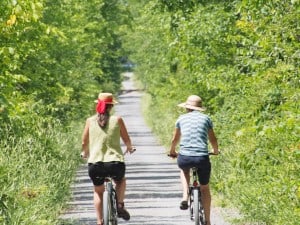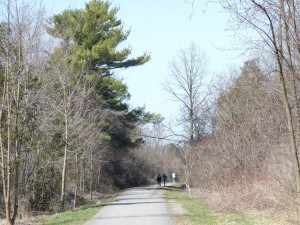It’s mid-May 2035, and I’ve just boarded a bus outside the new downtown condominium complex where my wife and I now live. It’s never more than a 10-minute wait for comfortable, clean and convenient public transit. On this particular morning, I’m heading up to Jackson Park, which is always a good birding location in spring when warblers are migrating north. Looking out the bus window, I can’t help but notice the many ways in which Peterborough has changed in the past two decades. The city now has a fully integrated transport system comprised of walkways, cycle paths, bus lanes and car lanes. There is even talk of a possible light-rail corridor to link Peterborough to Lakefield and Bridgenorth. In fact, train travel in general has become extremely popular in recent years, mostly because it’s far less expensive than driving. Thanks to big changes in the way Peterborough has developed, car ownership is no longer the necessity it once was. In fact, most families now only own one car or simply use the local car-sharing program when other means of transportation are not an option.
Talking about cars, I’m still amazed by the number of electric and hybrid vehicles on the road. For many years now, consumers have been demanding much greater fuel efficiency, given the huge rise in the cost of gasoline because of the federal carbon tax. This has led to the popularity of smaller and lighter vehicles. Putting a price on carbon was and still is a key tool in Canada’s on-going commitment to reduce greenhouse gas emissions by eight to ten percent a year. Canadians are keeping their fingers crossed but it now seems likely that the aggressive, worldwide action on climate change that began with the Paris Protocol of December 2015 will indeed limit the warming of the planet to under 2 C. Yes, intense storms are much more frequent than 20 or 30 years ago, but scientists are confident that the worse case scenario has been avoided.
It still seems miraculous but people all over the world finally woke up to the fact that an economy powered by fossil fuels and driven by free market ideology was leading the planet to climate chaos and suffocating any potential for climate action. A key result of this realization was a much greater willingness to accept government intervention and regulation of the economy and to support huge reinvestment in the public sphere – especially in new and updated infrastructure to withstand extreme weather events. No longer was “tax” a bad word, since well-funded government action was seen as the only way to respond to the climate threat. In Peterborough, there was also the recognition that the last thing our city should be doing in a time of climate disruption was to invest at great cost in even more roads – remember the Parkway debate way back in 2014? This, of course, would only have encouraged people to drive and pollute more with very little net gain in travelling time.
As the bus travels north on Charlotte Street, I can’t help but notice how so many of the commercial buildings and houses have changed, as well. One thing that stands out is the number of solar energy panels on the roofs. Along with wind turbines and hydroelectric power, solar provides a much greater percentage of the province’s energy needs than ever before. Although the population of Peterborough has continued to grow, all of the new housing has been provided within the existing city boundaries through intensification and redevelopment, namely rebuilding or restoring areas in a state of decline. Residential neighbourhoods are now mixed use and much higher density, thanks in part to renovations in single-family homes to create rental units and even small stores and businesses. These neighbourhoods now offer shopping, recreation opportunities and public services, all within walking distance. One housing option that’s particularly popular with Baby Boomers and Generation Xers is the large number of multi-story condominium complexes close to the Otonabee River and Little Lake. Easy access to the waterfront and to the downtown makes these condos a huge hit. People are justifiably proud that there have been no large housing developments on the city’s perimeter for over 20 years. Now, when you exit Peterborough, you immediately notice how urban development abruptly stops and farmland and natural areas begin. If there’s one word to describe the new Peterborough, it is “compact”.
Another feature that I love is that most of the new buildings, as well as the fourth and fifth floor additions on existing buildings in the downtown, are of an architectural and landscape style that respects local history, cultural heritage and even local geology and ecology. The upshot is that a sense of place permeates Peterborough. You know that you are in the Kawarthas. For people who remember how a sense of place was being lost in so much of the development in decades past, this has been a huge step forward. And nowhere is the sense of place stronger than in city’s public square, which doubles as a farmers’ market. Buying my fruit and vegetables here, I get a real sense of the wide range of cultural groups and ethnic mixes that now call our city home.
If the weather stays nice tomorrow and my aging knees and hips cooperate, I plan to ride my bike along the new greenway trails that run along both banks of the Otonabee River from the southern edge of the city up to Trent University. New side-branches link up with the Parkway Greenway in the north and Harper Park in the south. Kids love to play along the greenways, climbing trees or catching frogs in the ponds. These ribbons of green also provide migration corridors that allow birds and other wildlife to criss-cross the city safely, thereby increasing biodiversity. People are always so pleased to see wild animals close to their homes.
Jackson Park
As I get off the bus at Jackson Park and walk down the hill towards the recently refurbished pagoda, I stop for a moment to watch a small flock of warblers feeding in the trees. A Red-tailed Hawk also catches my attention as it brings food to its nest in the Park’s iconic White Pines. Further ahead by the pond, a group of high school students is absorbed in a sketching activity, while seniors stroll in the warm spring sunshine. Despite its urban location, Jackson Park still provides a welcome element of solitude. It’s a place where one can escape from the hustle and bustle of the city and enjoy relative peace and quiet. People shake their heads when they think of how close we came to seeing a noisy, polluting multi-lane bridge built over the park. However, at that time it was common to underestimate the value of nature. Little did we know that even a short walk in a neighbourhood green space could make us feel so much better. Just like exercise, sleep and a proper diet, it is now common knowledge that regular exposure to nature plays a key role in our mental, spiritual and physical health. It even improves our immune system and reduces heart rate and blood pressure. In a nutshell, it enhances our sense of well-being and therefore makes us happier. We’ve also learned that idle thought – especially in conjunction with walking in a natural setting – greatly enhances creativity and problem solving. Gone is the old attitude that the destruction of green space is justified as long as it results in material benefit or economic progress and that our cities can continue to grow forever until there’s nothing of the natural world left.
Pause for thought
This foray into the future – yes, it may be naive – should at least give us pause for thought. When you mark your ballot in the municipal election on October 27, please think about how your choices fit with the values expressed in this essay. Who we choose as our municipal leaders for the next four years will have a huge impact on the kind of development Peterborough can expect. More than anything, we need more politicians who will really listen to the public, a large part of which feels ignored by the present council and let down by the democratic process. This has been a council where willingness to compromise has been largely absent, where it’s often winner take all.
Although business and administrative skills maybe useful in the politicians we elect, they are not what’s most important. We need people with vision, who are fully aware that “business as usual” is no longer an option, especially with the reality of climate change looming over our heads. We also need men and women who understand the vital importance of green space and of a development model that no longer puts the private automobile front and centre. Many such people have their names on the ballot this year. Let’s hope we elect as many of them as possible.

